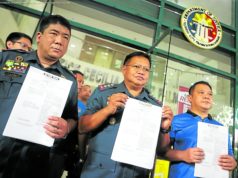As always, that can be used to a political advantage.
When President Trump visited Puerto Rico earlier this month, he emphasized one metric in an effort to demonstrate that the recovery effort was going well.
“Every death is a horror,” he said. “But if you look at a real catastrophe like Katrina, and you look at the tremendous hundreds and hundreds and hundreds of people that died, and you look at what happened here with, really, a storm that was just totally overpowering — nobody has ever seen anything like this.”
“What is your death count, as of this moment,” he asked the island’s governor. “Seventeen?”
“Sixteen,” Gov. Ricardo Rossello replied.
“Sixteen people certified. Sixteen people versus in the thousands,” Trump said. “You can be very proud of all of your people, all of our people working together. Sixteen versus literally thousands of people. You can be very proud.”
Trump’s reinforcement of that figure had a very specific aim. His administration had been heavily criticized for its response to the disaster and, by comparing the death toll from Maria to 2005’s Hurricane Katrina — for which his predecessor, George W. Bush, was similarly critiqued — Trump was trying to show that those concerns were overblown. That all had gone well.
By the time Trump had boarded Air Force One for the return flight to the mainland last week, that number had already more than doubled to 34. As of writing the toll is 45 — but it’s clear that the number will go up.
Earlier this week, BuzzFeed reported that funeral homes on the island had a number of corpses that weren’t included in the official death count. Some of those deaths weren’t related to the hurricane; people die every day. Some, it seems, were.
The question that arises, then, is: How are those fatality counts determined? What counts as a death from the storm and what doesn’t? And to what extent could an administration eager to keep that figure low put its finger on the scale?
To answer that question, The Washington Post spoke by phone with two professors at the University of Delaware, Joe Trainor and Benigno Aguirre, who work with the school’s Disaster Recovery Center .
To the core question — how do we determine exactly how many people died because of Maria — Trainor offered a sobering response.
“I think the answer is less satisfying than most people would expect,” he said. “The reality is, we probably will never know.”
The Centers for Disease Control’s National Center for Health Statistics collects data related to deaths due to natural disasters, Trainor said. There’s even a form that gets filled out.
But that’s further down the line. A representative for the CDC told The Post over email that “NCHS is not involved in producing the initial casualty estimates. They rely on death certificates, which tend to take longer to process.”
Those certificates are themselves open to interpretation.
“The official designation of any single individual’s death is really managed by the coroner at that specific place, or the medical official,” Trainor said. “And typically it doesn’t say ‘hurricane’ — it’s going to list whatever the medical condition that led to their death was.”
“The long and short of it is, no matter what system exists, there’s a lot of gray involved in how you will attribute any specific death during this time period,” he added, “whether you decide it’s directly or indirectly related to the event itself.”
Aguirre spoke to that.
“If the hurricane happened on day one and the death happens two or three days after or during it, it’s more likely those deaths will be counted as a result of the hurricane,” he said. “On the other hand, if it happened two or three weeks afterwards, then you have the problem that perhaps it’s not the case there’s a relationship.”
The type of death matters. A building weakened by the storm collapses on someone a week later or a person who can’t access critical medicine dies, those seem like strong candidates for having been indirectly related to the storm. What about someone who dies of a heart attack after struggling to find shelter after his house was destroyed? Is that not related at all?
There are also deaths that won’t be counted for other reasons. After the attacks of Sept. 11,2001, Aguirre learned that a number of undocumented immigrants worked in the Twin Towers and went missing after the buildings fell. Their families, though, were reticent to report those deaths to the government, so, from an official standpoint, those fatalities aren’t included in the overall number — or in public memorials.
All of this means that there’s leeway in how death totals are interpreted, some “cases that are gray,” in Trainor’s words. That’s exacerbated by the situation on the ground in Puerto Rico, which is a “mixed bag” in terms of the existing governmental infrastructure to tally deaths, in Aguirre’s estimation.
At the same time, there’s always a tension between the politics surrounding a natural disaster and official estimates of its effects.
“It’s always the possibility of turning it into a political issue,” Aguirre said. “That’s not only in the case of the Trump administration but in many other governments that either minimize or maximize the effects.”
In developing countries, he said, the number of deaths from disasters is often maximized to make the case for donations and support from the international community. In America, the political calculus is often different, Trainor said, with elected leaders often citing higher estimates for eventual death tolls that can then be revised downward.
“You don’t want to be the mayor who says there could be 100,000 people dead and it turns out there are 200,000 people dead,” he said. “But if you’re the mayor who says there are 100,000 dead and it turns out to be 90, people don’t get mad about that.”
Trump erred on the low side for a political reason. Because of the nature of tallying fatalities, it’s hard to say the extent to which the actual count will err on the low side as well.
Aguirre did offer one indirect defense of the administration.
“FEMA during [2005’s Hurricane] Katrina was accused of being a very bad actor because people died as a result of this,” he said. “By and large, a lot of those claims were unjustified” given the number of other factors at play.
Deeper questions about causes of death and ways in which disasters were made worse are “important to ask,” he noted.
Домой
United States
USA — Events We’ll probably never know exactly how many people died in the aftermath...





